The U.S. Department of Energy’s ARPA-E agency just announced $33 million in funding for thirteen fuel cell projects that can be used as low-cost power generation and grid balancing assets. The projects are being funded under ARPA-E’s new Reliable Electricity Based on Electrochemical Systems (REBELS) program that was announced last fall.
“The world of materials and grid technologies has moved so much” in just the past few years, Cheryl Martin, acting director of ARPA-E, said in an interview during New York Energy Week. “Distributed generation technologies like these could fundamentally change the way America generates and stores energy.”
Fuel cells, which convert chemical energy from a fuel source into electrical energy, have been touted for decades as a form of alternative energy, but high costs have kept them largely sidelined both in distributed power generation and transportation.
REBELS focuses on intermediate-temperature fuel cells (200°C to 500 °C), also known as ITFCs, which Martin said involves innovations happening at the materials layer. The projects fall into three categories starting with ITFCs for distributed generation, the category in which more than half of the awardees fall.
The next category of projects will integrate ITFCs and electrical storage at the system level, so that fuel cells can be used for grid balancing. The third category of ITFCs will produce liquid fuels from gaseous hydrocarbons, such as methane. The goal of the REBELS program is to reach installed costs of less than $1,500 per kilowatt at moderate production volumes.
“It could be an additional piece in the evolving grid,” Martin said of fuel cell breakthroughs. The REBELS program joins ARPA-E’s GENI, GRIDS and ADEPT programs that are also funding technologies that could contribute to a more efficient, distributed grid.
The biggest winner in this round of REBELS funding was Redox Power Systems, which received $5 million for its low-temperature solid oxide fuel cell. Last year, Redox told Greentech Media that it could push the cost of fuel cells down to as little as $800 per kilowatt at volume production, less than one-tenth the cost per kilowatt of Bloom’s fuel cells. Redox will use the ARPA-E funding to develop a mid-temperature fuel cell operating at 400°C that uses a novel material configuration which will increase the power density while still allowing for stability.
SAFCell, a spinout from the California Institute of Technology, received the second-largest award: $3.7 million. It is developing a solid acid fuel cell that will operate at 250°C and uses virtually no precious metals. Instead, it uses carbon nanotubes as the basis for its catalysts.
Among the three winners for liquid-fuel producing fuel cells, FuelCell Energy received $3.5 million to convert methane to methanol. FuelCell, which had its IPO in 1992, focuses on megawatt-sized fuel cells. As of last year, it told Greentech Media that it was selling its current units, which use molten carbonate technology, for about $3,000 per kilowatt, excluding installation.
Another Connecticut-based company, United Technologies Research Center, received $3.2 million for a residential fuel cell that will combine a building’s heating and power systems.
Other winners include:
Oak Ridge National Laboratory – Oak Ridge, TN - Nanocomposite Electrodes for a Solid Acid Fuel Cell Stack - $2,750,000
Colorado School of Mines – Golden, CO - Fuel-Flexible Protonic Ceramic Fuel Cell Stack - $1,000,000
Georgia Tech Research Corporation – Atlanta, GA - Fuel Cell Tailored for Efficient Utilization of Methane - $1,000,000
Palo Alto Research Center – Palo Alto, CA - Reformerless Fuel Cell - $1,500,000
SiEnergy Systems – Cambridge, MA - Hybrid Fuel Cell-Battery Electrochemical System - $2,650,000
The University of California Los Angeles – Los Angeles, CA - Fuel Cells with Dynamic Response Capability - $1,000,000
The University of South Carolina – Columbia, SC - Bi-functional Ceramic Fuel Cell Energy System - $3,200,000
Argonne National Laboratory – Argonne, IL - Hybrid Fuel Cell System for Converting Natural Gas to Electricity and Liquid Fuels - $2,000,000
Materials & Systems Research, Inc. – Salt Lake City, UT - Electrogenerative Cells for Flexible Cogeneration of Power and Liquid Fuel - $2,800,000
For more on the REBELS projects, click here.
In its first five years, ARPA-E has funded close to 400 projects with an aggregate award total of nearly $1 billion. Martin said the focus for the first few years was on development and deployment of projects. Now, strategic partners are brought in at the very beginning of the process, rather than along the way. For the REBELS program, that could mean potential customers such as the military, utilities, and incumbent materials companies, such as BSF or Dow.
“Strategics don’t have to agree upfront about what the technology will be used for,” said Martin. “We just want to change the paradigm of what’s possible.”



